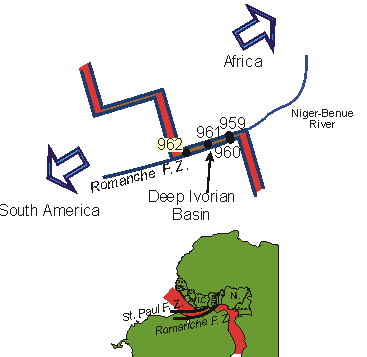Separation of South America from west Africa at the Romanche
Fracture Zone
Ocean Drilling Program Leg 159 to the Cote d'Ivoire Basin
ODP Leg 159
As South America and Africa separated, a pull-apart basin opened up, the
Deep Ivorian Basin, between the St. Paul and Romanche fracture zones. It filled
with sand and mud. The spreading center passed by the basin (actually, Africa
passed by the spreading center), heating up sediment in the basin. ODP Leg 159
set out to uncover when the bypass occurred, and how hot did the sediment get.
Four sites were drilled, and three of them provided sufficient age control
to allow the timing of sediment heating to be determined: Sites 959, 960, and
962.
Clays undergo a predictable alteration as temperature increases, provided
that there is sufficient potassium (K) in the sediment, sufficient permeability
to allow fluids to circulate and promote the alteration, and sufficient time
and/or temperature increase occurs (see references).
Sediment at Sites 959, 960, and 962 indicate temperatures increased to up
to 170°C, as indicated by the presence of R=0 I/S clay (sometimes called
"mixed-layer clay").
Stage 1:
As rifting begins, a pull-apart basin opens between the St. Paul and Romanche
Fracture zones. It fills with terrestrial to marginal-marine sediment. |
 |
Stage 2:
The basin widens as rifting proceeds. Deposition proceeds, and the sediment
is not yet affected by the high temperatures of the spreading center. |
 |
|
Stage 3:
The spreading center begins to pass by Sites 959 and 960 in the eastern
part of the basin, cooking the sediment to up to 170°C, as indicated by
the presence of R=1 I/S clay.
It's late Albian time. Younger sediment has only R=0 I/S clay, indicating
that it's temperature was not elevated, and so was deposited after the
ridge passed and things cooled off.
|
 |
|
Stage 4:
The rift passes the western part of the basin, cooking sediment at Site
962, again indicated by the presence of R=1 I/S clay.
The timing is latest Albian. Younger sediment shows no indication
of heating, as indicated by the presence of R=0 I/S clay, and the absence
of R=1 or R=3 I/S clay.
|
 |



